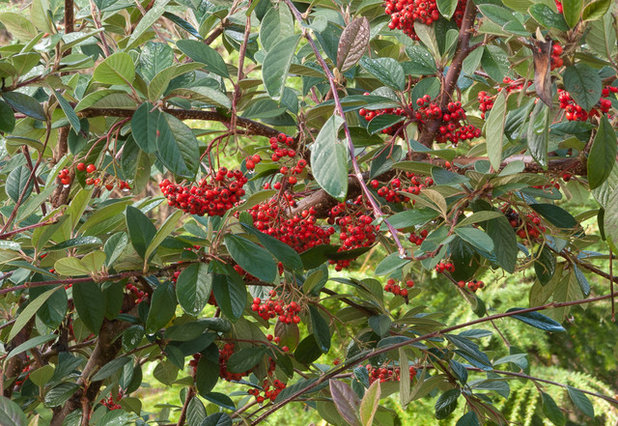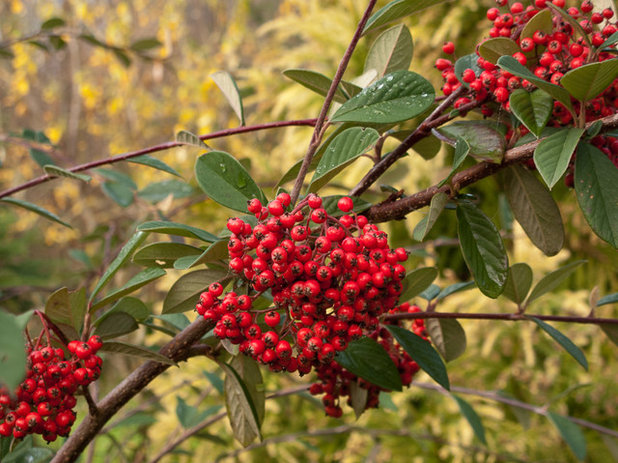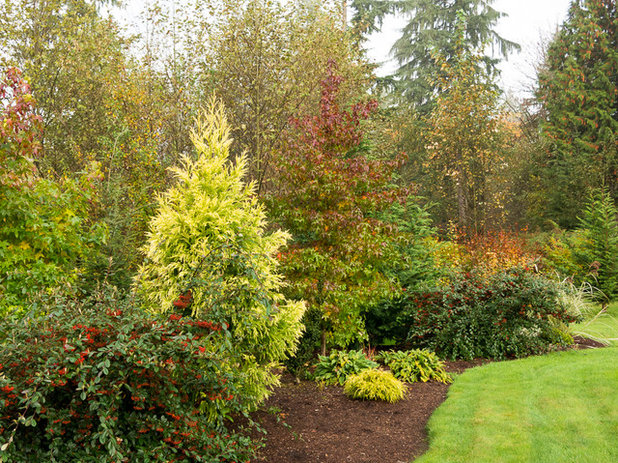Parney cotoneaster (
Cotoneaster lacteus) is an informal evergreen shrub that is as attractive to wildlife as it is to gardeners, particularly gardeners in the Pacific Northwest region of the United States. California gardeners may want to try the native Toyon (
Heteromeles arbutifolia), which is more suitable for California’s climate and wildlife. This shrub is best known for its cool-season berries but offers year-round appeal. While it does need space for its beauty to really be showcased, it can also be trained loosely against a wall, allowing the lax berried branches to tumble downward.
It forms a large, loose mound of arching branches clothed with dark green leaves. Turn the leaves over and you will see the soft, felted, silvery underside, which shimmers in the slightest breeze. In late spring flat sprays of white flowers keep the bees happy. As the flowers ripen into clusters of red berries, it will become clear that the birds will favor your garden over others without this plant. Robins seem to find the treats especially tasty. Thankfully, the deer leave these plants alone for the most part, tasting the new shoots of a few branches in spring but rarely doing serious damage.
Caution: Contoneaster may be invasive in your area. Check the Invasive Plant Atlas of the United States before planting.

Le jardinet
Botanical name: Cotoneaster lacteus (syn.
Cotoneaster parneyi)
Common names: Parney cotoneaster, milk flower cotoneaster
Origin: China and northern India
Where it will grow: Hardy to -10 degrees Fahrenheit (USDA zones 6 to 8; find your zone)
Water requirement: Average to low
Light requirement: Full sun to dappled shade
Mature size: 8 to 10 feet tall and wide

Le jardinet
Benefits and tolerances: - Deer resistant (usually)
- Flowers attract bees
- Berries attract birds
- Drought-tolerant once established
- Low maintenance
- Tolerates clay soils
Seasonal interest: Year-round
When to plant: Spring or fall
Distinguishing traits:- Evergreen
- Dark green leaves with a shimmery silver underside, which catches the light beautifully in the breeze
- Sprays of white flowers in summer
- Clusters of red berries that persist through winter or until the birds find them
- Great winter interest

Le jardinet
How to use it. This arching shrub is certainly versatile. Here are a few suggestions for how to use it:
- As a transitional shrub between a more formal garden and less cultivated areas beyond
- As a dense evergreen hedge, either free form or loosely trained as an espalier
- As part of a mixed border, as shown here, planted with golden conifers and colorful deciduous trees
Planting notes. Plant this cotoneaster in average, well-drained soil. It doesn’t need any special fertilizers or care. Don’t be too hasty with spring cleanup. After an especially hard winter, one of my shrubs died almost to the ground but quickly regrew from the base.
More: Feed the Birds: 6 Plants for Abundant Winter Berries





